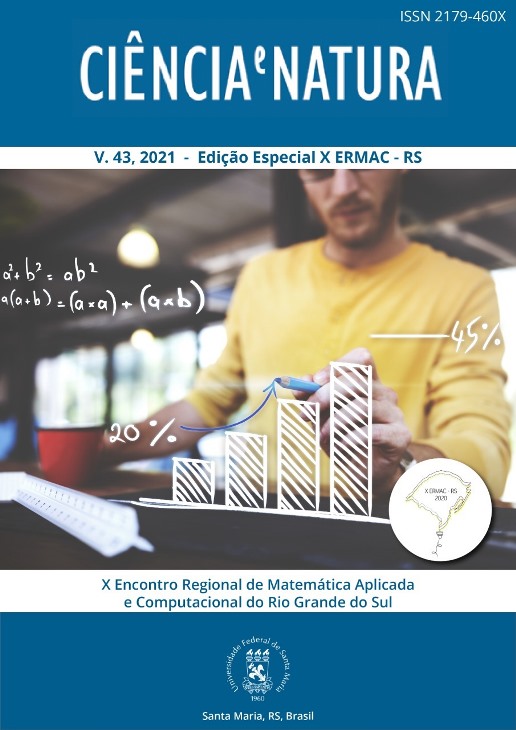Uma abordagem matemática para a previsão do adensamento das argilas saturadas
DOI:
https://doi.org/10.5902/2179460X66836Palavras-chave:
Andesamento, Viscosidade, Não linearidade, Argila saturadaResumo
As camadas argilosas saturadas submetidas a um carregamento vertical recuperar deformações verticais ao longo do tempo, isto é, adensamento. Essas deformações quando acentuadas provocam danos ocorrem, afetam ou estéticos nas edificações. Neste sentido, aqui um modelo matemático é proposto e desenvolvido para a previsão do adensamento das argilas saturadas levando-se em conta os conceitos básicos por Terzaghi e Frohlich (1936), Taylor (1942) e Barden (1965). A família matemática considera a existência de uma parcela viscosa da tensão efetiva vertical e incorporada no equação diferencial parcial modelada uma lei de viscosidade não linear como uma propriedade fundamental. A corrigido equação do adensamento é obtida em termos de dissipação do excesso de poropressão normalizada. Em vista da complexidade do modelo, a técnica numérica de diferenças divididas finitas é utilizada para obter a solução teórica considerando variações no tempo e no espaço. A solução numérica mostra que uma parcela viscosa da tensão efetiva vertical atua retardando o fenômeno do adensamento. Além disso, o ajuste dos valores teóricos aos experimentais mostra que a modelagem para o fator viscosidade igual a um é mais promissora do que as propostas por Terzaghi e Frohlich (1936) e Andrade (2014).
Downloads
Referências
ANDRADE, M. E. S. (2014). Adensamento unidimensional considerando a resistência viscosa à compressão. PhD dissertation,Universidade Federal do Rio de Janeiro.
BARDEN, L. (1965). Consolidation of clay with non-linear viscosity. Géotechnique, 15(4), 345–362.
BRAJA, M. (2011). Fundamentos de Engenharia Geotécnica, 6º edn. Cengage Learning.
CARVALHO, S. R. L. (1997). Uma teoria de adensamento com compressão secundária. PhD dissertation, Universidade Federal doRio de Janeiro.
TAYLOR, D. W. (1942). Research on Consolidation of Clays, 1º edn. Massachusetts Institute of Technology.
TERZAGHI, K., FROHLICH, O. K.(1936). Theorie der Setzung von Tonschichten, 1º edn. Franz Deuticke.
Downloads
Publicado
Como Citar
Edição
Seção
Licença
Copyright (c) 2021 Ciência e Natura

Este trabalho está licenciado sob uma licença Creative Commons Attribution-NonCommercial-ShareAlike 4.0 International License.
Para acessar a DECLARAÇÃO DE ORIGINALIDADE E EXCLUSIVIDADE E CESSÃO DE DIREITOS AUTORAIS clique aqui.
Diretrizes Éticas para Publicação de Revistas
A revista Ciência e Natura está empenhada em garantir a ética na publicação e na qualidade dos artigos.
A conformidade com padrões de comportamento ético é, portanto, esperada de todas as partes envolvidas: Autores, Editores e Revisores.
Em particular,
Autores: Os Autores devem apresentar uma discussão objetiva sobre a importância do trabalho de pesquisa, bem como detalhes e referências suficientes para permitir que outros reproduzam as experiências. Declarações fraudulentas ou intencionalmente incorretas constituem comportamento antiético e são inaceitáveis. Artigos de Revisão também devem ser objetivos, abrangentes e relatos precisos do estado da arte. Os Autores devem assegurar que seu trabalho é uma obra totalmente original, e se o trabalho e / ou palavras de outros têm sido utilizadas, isso tem sido devidamente reconhecido. O plágio em todas as suas formas constitui um comportamento publicitário não ético e é inaceitável. Submeter o mesmo manuscrito a mais de um jornal simultaneamente constitui um comportamento publicitário não ético e é inaceitável. Os Autores não devem submeter artigos que descrevam essencialmente a mesma pesquisa a mais de uma revista. O Autor correspondente deve garantir que haja um consenso total de todos os Co-autores na aprovação da versão final do artigo e sua submissão para publicação.
Editores: Os Editores devem avaliar manuscritos exclusivamente com base no seu mérito acadêmico. Um Editor não deve usar informações não publicadas na própria pesquisa do Editor sem o consentimento expresso por escrito do Autor. Os Editores devem tomar medidas de resposta razoável quando tiverem sido apresentadas queixas éticas relativas a um manuscrito submetido ou publicado.
Revisores: Todos os manuscritos recebidos para revisão devem ser tratados como documentos confidenciais. As informações ou ideias privilegiadas obtidas através da análise por pares devem ser mantidas confidenciais e não utilizadas para vantagens pessoais. As revisões devem ser conduzidas objetivamente e as observações devem ser formuladas claramente com argumentos de apoio, de modo que os Autores possam usá-los para melhorar o artigo. Qualquer Revisor selecionado que se sinta desqualificado para rever a pesquisa relatada em um manuscrito ou sabe que sua rápida revisão será impossível deve notificar o Editor e desculpar-se do processo de revisão. Os Revisores não devem considerar manuscritos nos quais tenham conflitos de interesse resultantes de relacionamentos ou conexões competitivas, colaborativas ou outras conexões com qualquer dos autores, empresas ou instituições conectadas aos documentos.






